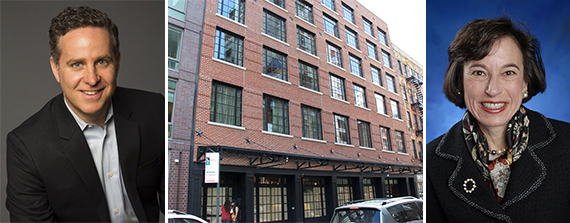Trending
The Lower East Side goes upscale: Q&A, part I
David Schneiderman and Deborah Gutoff on the neighborhood's "original game changer"

From the February issue: The Lower East Side is a long-gritty neighborhood that’s undergoing a dramatic makeover. Driving the transformation is the $1.1 billion Essex Crossing mega project, which is set to deliver 1,000 units of housing along with retail, office, and community/cultural uses. In our first web installment, we bring you TRD‘s interviews with David Schneiderman, co-founder of Four Winds Real Estate and Deborah Gutoff, senior director of Eastern Consolidated, who talk about the neighborhood’s “original game changer,” as well as what kind of investment opportunities they are seeing right now.
David Schneiderman
Co-Founder, Four Winds Real Estate
How much is buying/renting activity up or down by on the LES now compared to the last few years? Is there a serious influx of buyers/renters or has activity started to recede?
Rental activity on the LES continues to increase and we expect this trend to continue as Essex Crossing blossoms over the next few years. Tenants are attracted to the unmatched cultural amenities — bars/restaurants and art galleries — that the neighborhood has to offer.
What projects do you consider game-changers in the neighborhood? And what new benchmarks are they setting for the LES market?
Before Essex Crossing and Extell’s South Street tower, the original game-changer for the LES was the Ludlow Hotel. The developers of the hotel have always been leading indicators for neighborhoods that were primed to transform. Prior to the Ludlow Hotel, they created the Bowery Hotel, Mercer Hotel and Marlton Hotel. They also wisely filled the valuable retail space with [the bistro] Dirty French from Major Food Group. This has attracted the fashion crowd to the neighborhood en masse.
The LES has long been one of the city’s most diverse neighborhoods. You have young hipsters, Chinese, Hispanics and a close-knit community of Orthodox Jews. How do you see the demographic changing over the next 10 years?
We are already seeing the demographics change in the neighborhood in our portfolio of rental buildings. In April, we bought a three-building portfolio for $49 million on the corner of Ridge and Rivington streets in partnership with Admiral Capital Group and USA Real Estate Company. Since closing we have seen higher-income tenants moving into the neighborhood. Over the next ten years the neighborhood will evolve much like Chelsea has over the past 10 years and we will see more families and an older demographic.
What do you see as the biggest challenges to development and investment on the Lower East Side? Do you think the market is too saturated with product right now?
The biggest challenge is finding development sites and investment properties at prices that make economic sense. Additionally, there are very few larger development sites available at any price on the LES. The market is far from saturated. There is a very limited supply of condominiums and new rental housing in the pipeline. The demand currently far exceeds the supply. With this said, it will be interesting to see if the current condominium prices of approximately $2,000-$2,500 a square foot hold when the inevitable slowdown occurs.
Deborah Gutoff
Senior Director, Eastern Consolidated
How much are prices up or down by on the rental side? And what are we seeing in terms of rental development in the neighborhood?
We’re seeing monthly residential rents range from $2,100 for a studio to $7,000 for a two-bedroom, with the average price per square foot rising to as high as $80 for renovated, amenitized product. Our analysis of four multi-family buildings that sold in the last six months shows that these properties will be maintained as rentals in the near term, and in at least one case, repositioned as a luxury rental with high-end retail.
How much is buying/renting activity up or down by on the LES now compared to the last few years? Is there a serious influx of buyers/renters or has activity started to recede?
The influx of millennials is driving up rents because many apartments are shared, with young people paying between $1,500 and $2,000 per month in rent for a bedroom. While this 25- to 35-year-old demographic is willing and able to pay high rents, we’re not seeing many of them enter the condo market because they enjoy the flexibility of renting or can’t afford to buy yet.
What’s going on with retail rates on the LES? How much are they up or down by in the last year or two?
The increased foot traffic that Essex Crossing’s 1,000 new apartments, office and retail is expected to bring is already being factored into the area’s retail rents, which are now well over $100 per square foot, a threshold rarely seen before on the Lower East Side.
What kind of development or investment opportunities are you looking for in the LES? Any deals you can share with us right now?
We’re currently marketing a 11,825- square-foot mixed-use apartment building for redevelopment at 125 Rivington Street, one block from Essex Crossing, for $11.4 million. The investor/user interest in this property has been particularly strong.
To read the rest of the Q&A, click here.




